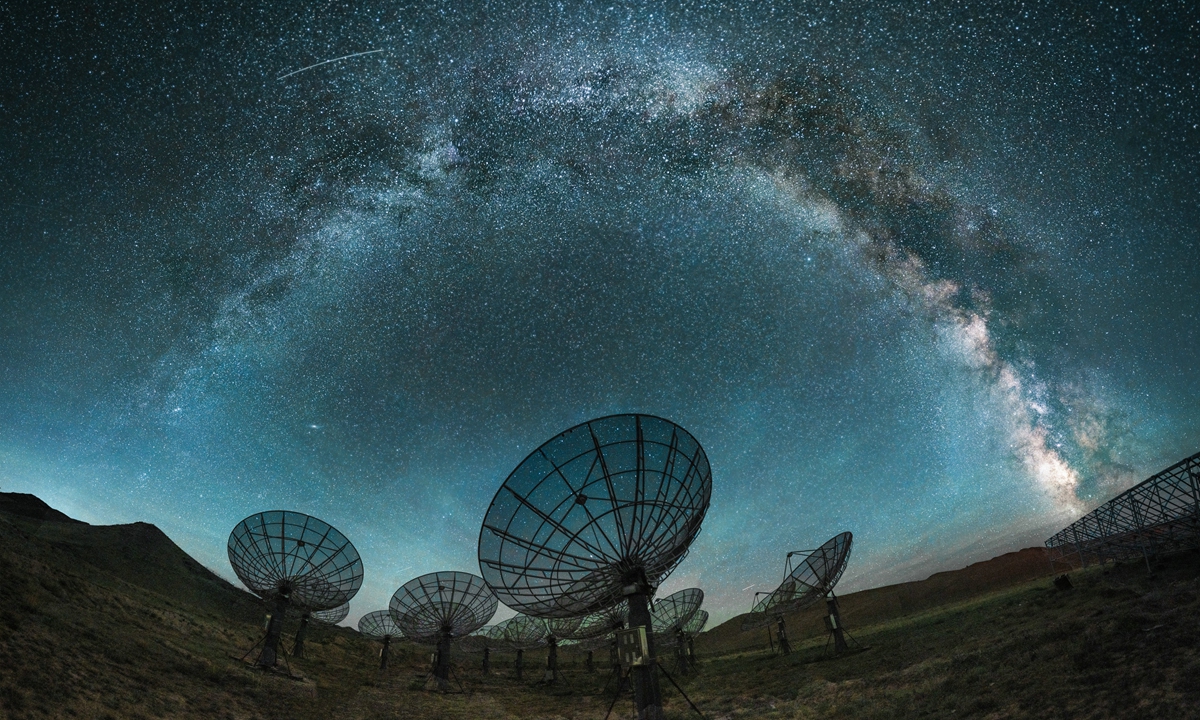China's first dark energy radio detection project certified as SKA Pathfinder, to provide new scientific insights

The dark energy radio detection experiment, also called the Tianlai project, creates a spectacular scene under the night sky. (Photo: courtesy of the National Astronomical Observatories of the Chinese Academy of Sciences)
The Tianlai experimental array, China's first dark energy radio detection project, has been successfully certified as a SKA Pathfinder by the Square Kilometre Array (SKA) organization, an intergovernmental organization with 10 international member states, the Global Times learned from the National Astronomical Observatories of the Chinese Academy of Sciences on Monday. The recognition is expected to offer new opportunities for scientific exploration and test innovative detection technologies for the SKA.
The project is located at an observation station in Hami, Northwest China's Xinjiang Uygur Autonomous Region. It primarily conducts neutral hydrogen surveys, which are used to study the large-scale structure of the universe, dark energy, and other cutting-edge cosmological topics.
According to astronomical observations, about 70 percent of the universe is composed of mysterious dark energy, which is causing the accelerated expansion of the universe.
The array features both cylindrical and dish-shaped antennas. The cylindrical array consists of three paraboloid reflector antennas, each equipped with 96 feeds, while the dish array includes 16 six-meter diameter parabolic antennas.
As a SKA Pathfinder project, the Tianlai array can test technologies for detecting neutral hydrogen, allowing for the extraction of faint 21-centimeter hydrogen signals. "These techniques can be applied to the SKA project. Through practical observations and data analyses, we can identify real-world issues that theoretical analyses alone cannot fully address," said Chen Xuelei, chief scientist of the Tianlai project and researcher at the National Astronomical Observatories.
Robert Braun, the science director of the SKA, noted that the Tianlai project will pave the way for the SKA radio observatory. Although the organization is in its initial operational phase, the existing radio antennas and experimental projects will continue to provide insights for scientific plans and research foundations, Braun said.
In addition, these technologies can also be applied to future large-scale astronomical telescope projects, the Global Times learned from the National Astronomical Observatories.
The SKA is a next-generation giant radio telescope array currently under construction, representing an intergovernmental collaboration involving 10 countries, including China, South Africa, the UK, and Australia. The SKA Pathfinder project includes various large scientific instruments from around the world related to SKA science and technology.
Photos
Related Stories
- Proportion of 'lighthouse factories' from China reaches new high in WEF’s new list
- Chinese scientists develop technology for sustainable production of industrial chemicals
- China unveils future space science plan
- Dongshan county in SE China's Fujian province strives to build new energy industrial chain
- CHN Energy Investment Group launches 170 billion yuan project in Xinjiang's Hami
Copyright © 2024 People's Daily Online. All Rights Reserved.









